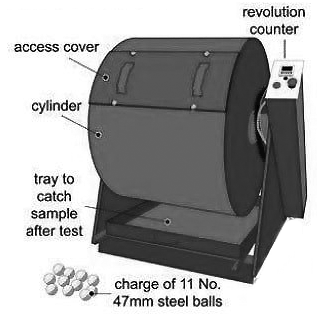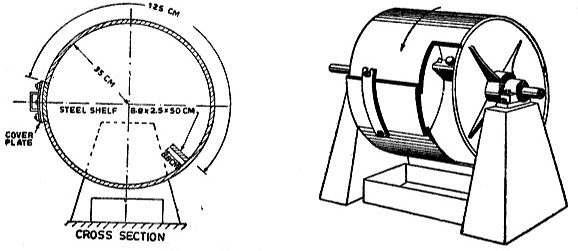Apparatus
The apparatus shall consist of the following :
- Los Angeles machine - The Los Angeles abrasion testing machine, conforming in all its essential characteristics to the design shown
in Fig, shall be used. The machine shall consist of a hollow steel cylinder, closed at both ends, having an inside diameter of
700 mm and an inside length of 500 mm. The cylinder shall be mounted on stub shafts attached to the ends of the cylinders but
not entering it, and shall be mounted in such a manner that it may be rotated about its axis in a horizontal position. An opening
in the cylinder shall be provided for the introduction of the test sample. The opening shall be closed dust-tight with a removable
cover bolted in place. The cover shall be so designed as to maintain the cylindrical contour of the interior surface unless the shelf is so
located that the charge will not fall on the cover, or come in contact with it during the test. A removable steel shelf, projecting radially
88 mm into the cylinder and extending its full length, shall be mounted along one element of the interior surface of the cylinder.
The shelf shall be of such thickness and so mounted, by bolts or other approved means, as to be firm and rigid. The position of
the shelf shall be such that the distance from the shelf to the opening, measured along the circumference of the cylinder in the direction
of rotation, shall be not less than 1250 mm.
- Sieves - The 1.70-mm IS Sieve.
- Abrasive Charge -The abrasive charge shall consist of cast iron spheres or steel spheres approximately 48 mm i. diameter and each
weighing between 390 and 445 g

Los Angeles Abrasion Test Machine - Model
Los Angeles Abrasion Test Machine - Model

Los Angeles Abrasion Test Machine - Diagram
Los Angeles Abrasion Test Machine - Diagram
Preparation of the Test Sample
The test sample shall consist of clean aggregate which has been dried in an oven at 105 to 110°C to substantially constant weight
and shall conform to one of the gradings shown in Table. The grading or gradings used shall be those most nearly representing the aggregate
furnished for the work.
Note:
It is recognized that different specification limits may be required for gradings
E, F and G than for A, B, C and D. It is urged that investigations be conducted to determine the relationship, if any,
which exists between results for these coarse gradings using the 10000 gm samples and the finer ones using the 5000 gm samples.
Table - Grading of Test Samples for Los Angeles Abrasion Test
| Grading |
Weight in grams of each lest sample in the size range mm (passing and retained on square holes) |
No. of spheres |
Weight of charge gms. |
| 80-63 |
63-50 |
50-40, 40-25 |
25-20 |
20-12.5 |
12.5-10 |
10-6.3 |
6.3-4.75 |
4.75-2.36 |
| A |
- |
- |
- |
1250 |
1250 |
1250 |
1250 |
- |
- |
- |
12 |
5000±25 |
| B |
- |
- |
- |
- |
- |
2500 |
2500 |
- |
- |
- |
11 |
4584±25 |
| C |
- |
- |
- |
- |
- |
- |
- |
2500 |
2500 |
- |
8 |
3330±2 |
| D |
- |
- |
- |
- |
- |
- |
- |
- |
- |
5000 |
6 |
2500+15 |
| E |
2500' |
2500 » |
5000 |
- |
- |
- |
- |
- |
- |
- |
12 |
5000+25 |
| F |
- |
- |
5000" |
5000 * |
- |
- |
- |
- |
- |
- |
12 |
5000±25 |
| G |
- |
- |
- |
5000 * |
5000 |
- |
- |
- |
- |
- |
12 |
5000+25 |
Note: Tolerance of ±2 percent is permitted
Test Procedure
- The test sample and the abrasive charge shall be placed in the Los Angeles abrasion testing machine and the machine rotated at a speed of
20 to 33 rev/min. For gradings A, B, C and D, the machine shall be rotated for 500 revolutions; for gradings E, F and G, it shall be rotated for 1000
revolutions. The machine shall be so driven and so counter-balanced as to maintain a substantially uniform peripheral speed. If an angle
is used as the shelf, the machine shall be rotated in such a direction that the charge is caught on the outside surface of the angle.
At the completion of the test, the material shall be discharged from the machine and a preliminary separation of the sample made on a
sieve coarser than the l.70-mm IS Sieve. The finer portion shall then be sieved on a 1.70-mm IS Sieve.
- The material coarser than the 1.70-mm IS Sieve shall be washed dried in an oven at 105 to 110°C to a substantially constant weight, and accurately weighed to the
nearest gram.
Note
Attention is called to the fact that valuable information concerning the uniformity of the sample under test may be obtained by determining
the loss after 100 revolutions. When this determination is made, care should be taken to avoid loss of any part of the sample;
the entire sample, including the dust of abrasion, shall be returned to the testing machine for the completion of the test.
Calculate Aggregate Abrasion Value
Difference between the original weight and the final weight of the test sample shall be expressed as a percentage of the original weight of the test sample.
This value shall be reported as the percentage of wear.
Aggregate Abrasion Value =
Where,
- WA is Original weight of aggregate in gm
- WB is Weight of material retain on 1.70 mm IS-sieve after test in gm
Reporting of Results
Difference between the original weight and the final weight of the test sample shall be expressed as a percentage of the original weight of the test sample.
This value shall be reported as the percentage of wear.